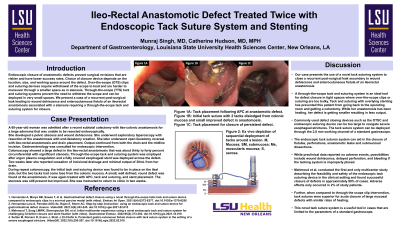Back


Poster Session B - Monday Morning
Category: Interventional Endoscopy
B0485 - Ileo-Rectal Anastomotic Defect Treated Twice With Endoscopic Tack Suture System and Stenting
Monday, October 24, 2022
10:00 AM – 12:00 PM ET
Location: Crown Ballroom

Has Audio

Munraj Singh, MD
Louisiana State University Health Sciences Center
New Orleans, LA
Presenting Author(s)
Munraj Singh, MD, Catherine Hudson, MD, MPH
Louisiana State University Health Sciences Center, New Orleans, LA
Introduction: The endoscopic tack suture system is a novel technique that includes a through the scope (TTS) suture-based device that was recently designed for the closure of large and irregular defects in the gastrointestinal tract. Choice of closure device depends on the location, size, and working space around the defect. Over-the-scope clips (OTSC) and endoscopic suturing devices require withdrawal of the scope to load and are harder to maneuver through smaller spaces such as strictures. The TTS tack suturing system prevents the need to withdraw the scope and can be deployed in very small spaces. We present a case of a recurrent post-surgical leak leading to wound dehiscence and enterocutaneous fistula of an ileorectal anastomosis associated with a stenosis requiring the tack suture device and stenting for closure.
Case Description/Methods: A 60-year-old woman was admitted after a recent subtotal colectomy with ileo-colonic anastomosis for a large adenoma that was unable to be resected endoscopically. She developed a pelvic abscess and wound dehiscence. She underwent exploratory laparoscopy with resection of the anastomosis with end-ileostomy creation. She later underwent open ileostomy reversal with ileo-rectal anastomosis and drain placement. Output continued from both the drain and the midline incision. Colonoscopy showed a large defect in the ileo-rectal anastomosis that was 40% circumferential with significant stenosis. The tack suturing system was employed after argon plasma coagulation (APC) and a fully covered esophageal stent was deployed across the defect (Figure 1A). During repeat colonoscopy, the initial tack and suturing device was found to be in place on the ileal mucosa, but two tacks had dislodged from the colonic mucosa. An improved small, well defined, round defect was found at the anastomosis (Figure 1B). The defect was again treated with APC, tack suturing, and stent placement with subsequent resolution of symptoms (Figure 1C).
Discussion: This case highlights the novel tack suturing system which ultimately prevented this patient from undergoing further operations and requiring a colostomy. The tack suture system is an ideal tool for defect closure in tight spaces where OTSC or endoscopic suturing are too bulky. Mahmoud et al. conducted the first and only multi-center study describing the feasibility and safety of the endoscopic tack suturing device in the clinical setting and found successful closure of defects in approximately 90% of cases.

Disclosures:
Munraj Singh, MD, Catherine Hudson, MD, MPH. B0485 - Ileo-Rectal Anastomotic Defect Treated Twice With Endoscopic Tack Suture System and Stenting, ACG 2022 Annual Scientific Meeting Abstracts. Charlotte, NC: American College of Gastroenterology.
Louisiana State University Health Sciences Center, New Orleans, LA
Introduction: The endoscopic tack suture system is a novel technique that includes a through the scope (TTS) suture-based device that was recently designed for the closure of large and irregular defects in the gastrointestinal tract. Choice of closure device depends on the location, size, and working space around the defect. Over-the-scope clips (OTSC) and endoscopic suturing devices require withdrawal of the scope to load and are harder to maneuver through smaller spaces such as strictures. The TTS tack suturing system prevents the need to withdraw the scope and can be deployed in very small spaces. We present a case of a recurrent post-surgical leak leading to wound dehiscence and enterocutaneous fistula of an ileorectal anastomosis associated with a stenosis requiring the tack suture device and stenting for closure.
Case Description/Methods: A 60-year-old woman was admitted after a recent subtotal colectomy with ileo-colonic anastomosis for a large adenoma that was unable to be resected endoscopically. She developed a pelvic abscess and wound dehiscence. She underwent exploratory laparoscopy with resection of the anastomosis with end-ileostomy creation. She later underwent open ileostomy reversal with ileo-rectal anastomosis and drain placement. Output continued from both the drain and the midline incision. Colonoscopy showed a large defect in the ileo-rectal anastomosis that was 40% circumferential with significant stenosis. The tack suturing system was employed after argon plasma coagulation (APC) and a fully covered esophageal stent was deployed across the defect (Figure 1A). During repeat colonoscopy, the initial tack and suturing device was found to be in place on the ileal mucosa, but two tacks had dislodged from the colonic mucosa. An improved small, well defined, round defect was found at the anastomosis (Figure 1B). The defect was again treated with APC, tack suturing, and stent placement with subsequent resolution of symptoms (Figure 1C).
Discussion: This case highlights the novel tack suturing system which ultimately prevented this patient from undergoing further operations and requiring a colostomy. The tack suture system is an ideal tool for defect closure in tight spaces where OTSC or endoscopic suturing are too bulky. Mahmoud et al. conducted the first and only multi-center study describing the feasibility and safety of the endoscopic tack suturing device in the clinical setting and found successful closure of defects in approximately 90% of cases.

Figure: Figure 1A: Tack placement following APC at anastomotic defect. Figure 1B: Initial tack suture with 2 tacks dislodged from colonic mucosa and small improved defect in anastomosis. Figure 1C: Tack placement for closure of persistent defect.
Disclosures:
Munraj Singh indicated no relevant financial relationships.
Catherine Hudson indicated no relevant financial relationships.
Munraj Singh, MD, Catherine Hudson, MD, MPH. B0485 - Ileo-Rectal Anastomotic Defect Treated Twice With Endoscopic Tack Suture System and Stenting, ACG 2022 Annual Scientific Meeting Abstracts. Charlotte, NC: American College of Gastroenterology.
